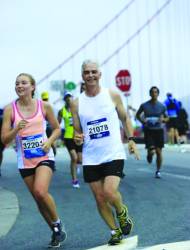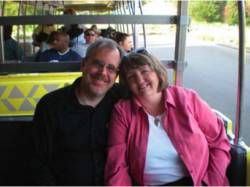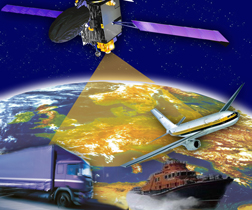 Running San Francisco Marathon, with daughter, Tanera. Note GPS watch.
Running San Francisco Marathon, with daughter, Tanera. Note GPS watch.SIDEBAR: Frank van Diggelen’s Compass Points
“It all traces back to my parents,” says Frank van Diggelen. “My father, Tromp van Diggelen, was a surfer. He taught me to surf and swim, in that order, when I was five. I was racing sailboats before I was 10, and there’s a lot of navigation there. Even when you’re just on a lake, the racing is all about reading the wind, understanding angles of convergence, velocity-made-good, and so on.”
SIDEBAR: Frank van Diggelen’s Compass Points
“It all traces back to my parents,” says Frank van Diggelen. “My father, Tromp van Diggelen, was a surfer. He taught me to surf and swim, in that order, when I was five. I was racing sailboats before I was 10, and there’s a lot of navigation there. Even when you’re just on a lake, the racing is all about reading the wind, understanding angles of convergence, velocity-made-good, and so on.”
And then there was his mother, Judith, who sparked Frank’s early interest in engineering by buying him ever-more complex “Meccano” sets — similar to Legos “but much more mechanical: all metal, with actual nuts and bolts, gears, and electric motors. We used to spend many hours making elaborate machines, like little electric cars and motorcycles.”
Now an American citizen, van Diggelen is South African by birth.
“I grew up in an incredibly segregated society,” he recalls, referring to the South African government’s policy of apartheid that ended in1994 after nearly 50 years. “Everything was segregated — where you could live, what schools you could go to, and what cinemas, restaurants, beaches, buses, taxis, everything.”
One of his first memories of South Africa is an incident that occurred when he was four years old. “My mother was taking my sister and me out somewhere. We were waiting to catch a bus by a black sign with white lettering ‘Bus Stop.’ After a while, a bus stopped and the driver told us to go and look for a different bus stop, with a white sign and black letters,” indicating its designation for whites only.
“As a child you just accepted that that’s how things were,” van Diggelen says. “It wasn’t until I was in college that I really understood what was going on.”
His parents, Tromp and Judith, believed strongly in a good education for their children and always made sure that little Frank and his siblings, a brother and a sister, went to the best schools the family could afford.
“This required some creativity,” van Diggelen says, “since we had very little money, and my dad changed jobs and moved us to different towns frequently.”
Thus, at ages four to five, he found himself in a Jewish religious school, and, from 11–15, at a Catholic boarding school, with some regular government schools in between. “I think the belief in good education stuck,“ he says.
Today, satellite navigation, a natural extension of his early waterborne interests, has impressed itself into every facet of his life.
“There is no boundary between my work and non-work life,” he says. “I love what I do and do what I love. So, whether I’m sitting in the office, or running in the hills, or racing a sailboat, I’m working on or with GNSS, usually testing something new, and trying to figure out how to make it better.”
In the Navy
As an 18-year-old midshipman in the South African Navy, van Diggelen was responsible for maintaining and operating the navigation systems aboard a minesweeper, including the U.S. Navy’s TRANSIT system, the world’s first operational GNSS.
He considers that assignment at sea to be doubly fortunate. In addition to learning satellite navigation skills, his tour of duty took him away from the “border war” with Angola and Namibian guerrillas fighting to liberate South West Africa from South African control.
“I joined the military because all white men were conscripted back then,” he says. In the 1980s, South Africa had continued to occupy the Namibian region that it had administered under a League of Nations mandate which had been revoked by the United Nations in 1966.
Most South African conscripts drew infantry posts and the border war.
“Many of my friends were there at the border while I was being taught navigation,” he says. “So, this may have been the luckiest thing that ever happened to me. I think it was because I was school swimming captain that I got into the Navy.”
Again, he had another reason to thank his father for those early swimming lessons.
“Anyway, only two percent of the conscripts got into the Navy, and two percent of those got into officer’s school,” van Diggelen says. “For me it was like winning the lottery.”
The ‘Real’ Cambridge
After his stint in the Navy, van Diggelen went back to school, earning a bachelor’s degree at the University of the Witwatersrand, South Africa, and a Ph.D. in electrical engineering from Cambridge University in England, both on full academic scholarship.
Of course, going off to college would have been a bit boring if it had only been about getting an education. However, in addition to classes, he met his wife Alison at Cambridge University, where she was also a student. “Alison is from Scotland. We like to tease people by saying we met ‘half-way’ between South Africa and Scotland,” van Diggelen says. “Anyone who knows Scotland, England, and South Africa gets it.”
More serious matters were not far ahead. Van Diggelen was in the throes of writing up his Ph.D. thesis when another Alison – Alison Brown, CEO and founder of NAVSYS Corporation — visited his supervisor, Professor Keith Glover, who had been her professor when she was at Cambridge.
“He knew I was looking for a job,” says van Diggelen. “So, he called me and I had an ‘insta-interview’ with Alison [Brown]. I hadn’t shaved or changed clothes, and had hardly slept, for three days — I must have looked like the ideal candidate! Next thing I knew I was working in Colorado Springs, and I’ve never looked back.”
Meeting Up with GPS
Van Diggelen began working on GPS in 1992, with Brown and company at NAVSYS in Colorado. There, he helped design a receiver autonomous integrity monitoring (RAIM) system for the U.S. Coast Guard. The result was an operational system for verifying the integrity of the differential GPS location of aids to navigation, mostly buoys, on U.S. marine charts. The system was still in use over a decade later.
After NAVSYS, van Diggelen worked on GPS, GLONASS, and assisted GPS (A-GPS) for Ashtech, Magellan, and, crucially, Global Locate, a San Jose, California-based GPS technology company where, as VP-technology & chief navigation officer, he was involved in the TomTom ONE XL portable navigation device (PND) project for which Global Locate supplied its Hammerhead chip.
“This may have been the best-selling PND ever,” he says. “It was the first project I was involved in where we sold a million GPS chips.” As an aside he adds, “Now we sell almost that many every day!”
Global Locate got involved with TomTom because both groups were in the HP iPaq, the first smartphone to include GPS. “TomTom did the maps and we did the GPS chip,” says van Diggelen. Until then, Global Locate had focused on A-GPS, high sensitivity, first-fix technology.
“We had a really steep learning curve to manage turn-by-turn navigation; but we learned quickly,” van Diggelen says..”
Looking back, he says, that may have been the peak of the PND business, before smartphones made navigation free and ubiquitous. “I still have a working TomTom ONE that I use now and again; and I have an original still in the box, with Mr. T celebrity voice, on display in my office.”
iPhone 3G and beyond
Another handheld gadget that changed van Diggelen’s life, the iPhone 3G, was also equipped with Global Locate’s Hammerhead. “This was the smartphone that made GNSS what it is today,” van Diggelen says. “It wasn’t the first smartphone to include GPS, but it was the first iPhone with GPS, and then every other smartphone followed, and that’s why everyone on Earth now knows what GPS is.”
Shortly after winning the iPhone 3G contract, Global Locate company was acquired by Broadcom Corporation headquartered in Irvine, California. Following the acquisition, van Diggelen became vice-president of technology and Broadcom Fellow.
All of which has only meant more fun.
About Samsung’s Galaxy Note 4, with Broadcom inside, he says, “The GNSS in this phone, the BCM4773, marks the beginning of a new phase of GNSS chip architecture. It is a combined GNSS-Sensor Hub, also called a ‘Location Hub.’” For van Diggelen, this is a back-to-the-future moment for the industry; all cell-phone GNSS [signal processing] used to be host-based, to save on cost and size; now the chips are so small anyway that size is not the issue, battery life is.
Broadcom’s current GNSS chips operate on ultra-low power — a 95 percent savings compared to host-based processing, he says, “by doing GNSS in the background when the host application processor is asleep. This means we are once again making GNSS with system-on-chip architecture, like 20 years ago, but, after 10 iterations of Moore’s Law, a thousand times smaller and lower power.”
Van Diggelen’s current projects also include the BCM4771 and BCM4774. Both are successors to the BCM4773. And GPS has plenty of company on the company’s chips, which also support Galileo, BeiDou, GLONASS, satellite-based augmentation systems, Japan’s Quasi-Zenith Satellite System, and inertial sensors.
Indeed, another area that fascinates van Diggelen is sensor and GNSS integration. “I’ve been working on this for about 10 years,” he says. “You may not know it, but most smartphones use inertial sensors, in particular gyros and accelerometers, to aid the GNSS in urban canyons.”
The next big challenge, he says, is indoor navigation with the same accuracy that mobile device customers are used to outdoors: “It’s coming, but it requires an integration of sensors as well as other wireless technologies, like WiFi and Bluetooth.”
Family and Leisure
Now long established in the San Francisco Bay area, van Diggelen is a family man with two children. His wife Alison, now a noted Silicon Valley journalist, is creator of the Fresh Dialogues interview series and a contributor to the BBC World Service, Public Radio International’s The World, NPR’s KQED in San Francisco, and the Huffington Post.
“I’m a very bad example of the so-called ‘work-life’ balance,” van Diggelen admits. Luckily, he shares some major interests with his two kids, Lewis and Tanera. “Both my daughter and son enjoy running, and it’s a great way to spend time together.
“Like many children, they are forging their own paths,” he says. “ Both are interested in biology, which is great. I think biotech is today where electronics was in the fifties.”
He is also an avid fan of skiing — “Three years in Colorado with NAVSYS was a great way to make up for the geographic deficiencies of my birthplace.” — and hiking. “My son and I climbed Kilimanjaro when he was 14.”
But wherever he is, whomever he’s with, and whatever he’s doing, van Diggelen says, he’s always trying out some interesting new GNSS thing. This year it’s accelerometers on his skis, linked to GPS in his phone, primarily to analyze what happens over moguls.
“All I can say is that my children know far more about GNSS than they ever wanted to.”
And there’s sailing. On weekends van Diggelen is navigator and tactician aboard a racing yacht home-ported in Santa Cruz, California.
All the while, he does his best to maintain ties with the folks in South Africa.
“I try to visit at least once every two years,” he says. “It’s difficult since the San Francisco bay area is almost as far from Johannesburg as you can get. Luckily we have Skype!”
The Icing
Van Diggelen, not least of all, is also a passionate teacher, starting way back at the University of the Witwatersrand, where he ran the mathematics department of an all-volunteer weekend high school for children from the non-white townships of Soweto and Alexandra.
“School kids would spend every Saturday on our college campus,” he explains, “getting taught the school syllabus by college students.” The school had 10 math teachers, all, and about 700 school kids taking courses in engineering and physics as well as math.
The children were highly motivated, van Diggelen recalls. They had almost no instruction in mathematics in their regular schools. For example, in one part of Soweto, five high schools were served by one math teacher at that time, he says.
“I became good friends with some of the school students,” van Diggelen remembers, “and that really changed how I understood my own country. I think that whole experience has made me value education and enjoy teaching to this day.”
Throughout his career, van Diggelen has continued to lead seminars and training courses in his professional capacity. In addition, under the Lyceum school program, he taught navigation to middle school children in San Jose, California. Today he is a consulting professor at Stanford University, teaching post-graduate class on GNSS as well as GNSS-themed massive open online courses or MOOCs.
“Teaching GPS strongly influences me in my working life,” he says. “There are always great questions from students that challenge me to think better about what I thought I knew.”
So, like any good teacher, van Diggelen remains an active learner, and he credits many who have guided him on his way: “I’ve been really lucky to have the right mentors and colleagues at the right time, and there have been several important teachers through my career.”
Among the latter, of course, we should include the early inspiration of Tromp and Judith van Diggelen, who ultimately gave all of us one of the world’s leading GNSS engineers.




